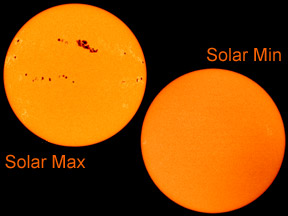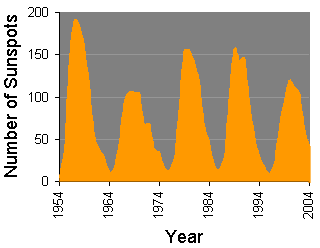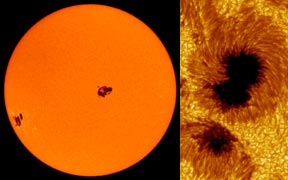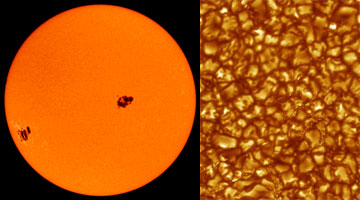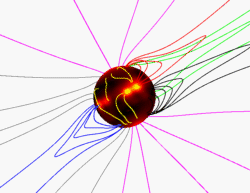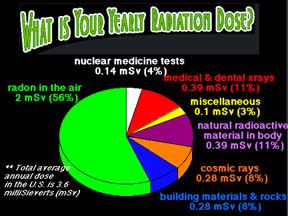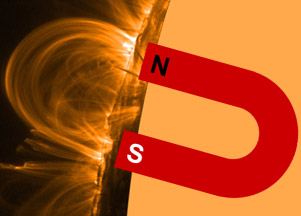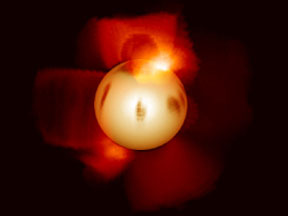The Sunspot Cycle
The number of sunspots seen on the "surface" of the Sun changes from year to year. This rise and fall in sunspot counts is a cycle. The length of the cycle is about eleven years on average. The Sunspot Cycle was discovered in 1843 by the amateur German astronomer Samuel Heinrich Schwabe. A peak in the sunspot count is called "solar maximum" (or "solar max"). The time when few sunspots appear is called a "solar minimum" (or "solar min"). An example of a recent sunspot cycle spans the years from the solar min in 1986, when 13 sunspots were seen, through the solar max in 1989 when more than 157 sunspots appeared, on to the next solar min in 1996 (ten years after the 1986 solar min) when the sunspot count had fallen back down to fewer than 9. The length of the sunspot cycle is, on average, around eleven years. But the length of the cycle does vary. Between 1700 and today, the sunspot cycle (from one solar min to the next solar min) has varied in length from as short as nine years to as long as fourteen years. Sometimes it is hard to get an exact count of number of sunspots on the Sun. Some spots are much bigger than others, some sunspots cross together at their edges, and many spots appear in groups. In 1848, a Swiss astronomer named Rudolf Wolf came up with the best way to count sunspots. The sunspot count using Wolf's formula, now known as the Wolf sunspot number, is still in use today. Wolf used data from earlier astronomers to reconstruct sunspot counts as far back as the 1755-1766 cycle, which he dubbed "cycle 1". Since then, subsequent cycles have been numbered consecutively, so the cycle that began with the 1996 solar minimum is cycle 23. The Sun is usually very active when sunspot counts are high. Sunspots show us where the Sun's magnetic field might be "twisted up" enough to cause solar flares and coronal mass ejections. The Sun gives off more radiation than usual during solar max, and this extra energy changes the uppermost layers of Earth's atmosphere. |
 History of Sunspot Observations
History of Sunspot Observations
 Activity: Graphing Sunspot Cycles
Activity: Graphing Sunspot Cycles
 Movie: Magnetic Field Lines Tangle as Sun Rotates
Movie: Magnetic Field Lines Tangle as Sun Rotates
 Movie: Rotating Sun with Sunspots
Movie: Rotating Sun with Sunspots
![]() Movie: Dark Days Ahead for the Sun (RealVideo courtesy of the National Science Foundation)
Movie: Dark Days Ahead for the Sun (RealVideo courtesy of the National Science Foundation)
 Picture: Solar Corona at Solar Max and Solar Min
Picture: Solar Corona at Solar Max and Solar Min
 Picture: X-ray Image of the Sun at Solar Max and Solar Min
Picture: X-ray Image of the Sun at Solar Max and Solar Min


